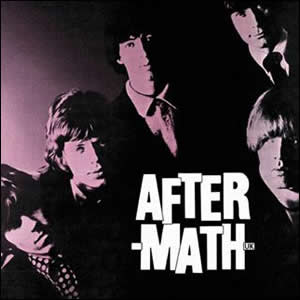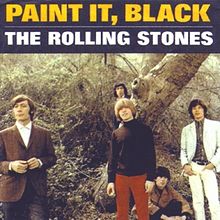Aftermath by The Rolling Stones
 Although it was their fourth album released in Britain and their sixth album released in America, Aftermath was really the second “true” album by The Rolling Stones, following 1965’s Out Of Our Heads. This one, like that previous one, was released in two distinct versions in the UK and in the USA, a common practice for the day (this review will look at the “greater” album, considering all the tracks included on either version of Aftermath). The UK hit single “Paint It Black” was added to the American version, replacing four songs that were included on the UK version.
Although it was their fourth album released in Britain and their sixth album released in America, Aftermath was really the second “true” album by The Rolling Stones, following 1965’s Out Of Our Heads. This one, like that previous one, was released in two distinct versions in the UK and in the USA, a common practice for the day (this review will look at the “greater” album, considering all the tracks included on either version of Aftermath). The UK hit single “Paint It Black” was added to the American version, replacing four songs that were included on the UK version.
With Out Of Our Heads, the band reached the peak of their mid-sixties (then cutting-edge) mixture of Chicago-style blues and pop-rock. Aftermath builds on this while it progresses the band more towards their distinct sound and image as “rock and roll’s bad boys”. It is also the first Stones album to include all original material, written by the tandem of Mick Jagger and Keith Richards. Although not himself a songwriter, multi-instrumentalist Brian Jones was the driving force behind some of the unique and distinct sonic quality of the album. Jones incorporated wider musical influences, such as psychedelia and folk, and widely expanded the use of instrumentation, with songs on Aftermath including touches of dulcimer, sitar, marimba, and various keyboards.
Aftermath was also the first Rolling Stones album to be recorded entirely in the United States at the legendary RCA Studios in Hollywood and it was the first album the band released in true stereo.
 Aftermath by Rolling Stones |
|
|---|---|
| Released: April 15, 1966 (Decca) Produced by: Andrew Loog Oldham Recorded: RCA Studios, Hollywood, December 1965-March 1966 |
|
| Side One | Side Two |
| Mother’s Little Helper Stupid Girl Lady Jane Under My Thumb Doncha Bother Me Goin’ Home |
Flight 505 High And Dry Out Of Time It’s Not Easy I Am Waiting Take It or Leave It Think What To Do |
| Song Included On U.S. Version | |
| Paint It, Black | |
| Band Musicians | |
| Mick Jagger – Lead Vocals, Harmonica Keith Richards – Guitars, Vocals Brian Jones – Guitars, Dulcimer, Sitar, Keyboards, Percussion, Vocals Bill Wyman – Bass, Organ Charlie Watts – Drums. Percussion, Marimba |
|
Much of the music’s backbone is still rooted in Chicago electric blues, with Jones’ instrumental tangents adding strategic flavoring to several songs. The opener “Mother’s Little Helper” contains a signature riff of heavily compressed 12-string electric guitar played with a slide. The song itself is a Beatle-esque, upbeat ode with a much darker message about drug dependency that made it one of the more thought provoking songs of the era.
“Stupid Girl” features a Fafsa organ by band manager and studio keyboardist Ian Stewart. It has the musical vibe of mid-sixties surf music and contains some juvenile lyrics that degrade the band’s groupies, one of several songs on the album that portray the fairer sex in a less-than-stellar light. Feminists have long lamented the message in “Under My Thumb”, which speaks of gaining the “upper hand” in a sexual relationship. No matter the message, the music to this song is absolutely brilliant, led by Jones’ marimba riff throughout with Richards’ acoustic and electric guitars and Bill Wyman‘s driving “fuzz” bass. Jones later brings back the marimba for the Phil Spector-esque “Out of Time”. This song was soon covered by English solo artist Chris Farlowe, whose recording was actually produced by Mick Jagger and reached number one on the UK singles in July, 1966.
 “Paint It, Black” is, in reality, constructed very similar to the band’s 1965 smash hit “Satisfaction”, in the sense that a catchy and heavy rock song is wrapped around a signature riff. However, the riff on “Paint It, Black” uses the much more exotic sitar which Jones recently learned from Beatles guitarist and Indian music enthusiast George Harrison. During the verse, drummer Charlie Watts adds to the atmosphere by playing a Middle Eastern-flavored drum pattern while Jagger contributed the dark lyrics, about depression, mourning, and cynicism. Keith Richard plays both electric and acoustic guitars as well as contributes background vocals to this hit song.
“Paint It, Black” is, in reality, constructed very similar to the band’s 1965 smash hit “Satisfaction”, in the sense that a catchy and heavy rock song is wrapped around a signature riff. However, the riff on “Paint It, Black” uses the much more exotic sitar which Jones recently learned from Beatles guitarist and Indian music enthusiast George Harrison. During the verse, drummer Charlie Watts adds to the atmosphere by playing a Middle Eastern-flavored drum pattern while Jagger contributed the dark lyrics, about depression, mourning, and cynicism. Keith Richard plays both electric and acoustic guitars as well as contributes background vocals to this hit song.
“Lady Jane” showcases Brian Jones on dulcimer and has a middle-age feel throughout due to its distinct instrumentation and precise vocals. Fans have long considered this song a hidden gem from Aftermath and critics have long argued that Jones deserved a song writing credit. The dulcimer is brought back by Jones on “I Am Waiting”, another good, meditative song.
Unfortunately, Aftermath does include a lot of filler as not all the songs hit the mark. “Goin’ Home” is an 11-minute blues jam, remarkable for its length in the era, but really Mundane in its delivery. “It’s Not Easy” is uninspired, basic filler while “Think” is a feeble attempt to rip-off “Satisfaction” with its buzz and precisely picked strings falling short of anything really interesting. Other songs are more interesting but don’t seem quite done, such as the bluesy “Doncha Bother Me”, the piano rocking “Flight 505”, and the upbeat, acoustic folk/bluegrass “High and Dry”, which has a nice edge due to Jagger’s vocals and Jones’ blues harp, but also contains an annoying, up-front and distracting hi-hat beat.

Aftermath would ultimately be the high-water mark for Brian Jones’ influence on the band. Over the next few years and albums, his contributions were eventually diminished in lieu of the Jagger/Richards influence until he was ultimately nudged out of the band in 1969. He died shortly thereafter under mysterious circumstances.
~
Part of Classic Rock Review’s celebration of 1966 albums.





May 6, 2016 @ 9:24 pm
A rolling stone is worth two in the bush, thanks to this arltice.
November 8, 2016 @ 6:53 am
If you look at the US incarnation the album has a perfect flow, punches harder, sounds darker, and still has a the whole gamut of styles (Under my Thumb is in the same vein as Out of Time, and stronger in my opinion, though the latter would find a nice place on the strange but delightful Flowers, just as Take it or Leave it, which with its poppy flavor fits better there as well). The US album also does not suffer from the overlong side B, where the songs drown themselves out on the UK version, especially after the 11 minute onslaught of Goin’Home, you just get lost, can’t bring up the attention anymore, which is a pity, even if some of the songs are a bit filler. The long jam with which Aftermath ends in the US makes more sense too in this context, it no longer interrupts the flow, it is a climax, surely after I am Wating which gets the pivotal position it deserves as second to last. Concerning the start, well, both versions have a great opener, yet Mother’s little Helper is coupled beautifully with Have You Seen Your Mother Baby (standing in the shadows) on Flowers, so my choice is made. Just miss What To Do a bit, even if it recycles the drum riff of Congratulations.
September 14, 2018 @ 7:30 pm
“Filler”? Songs like Think and Going Home sre classics – how many bands from the Beatles to the Doors followed the Stones into extending and expermenting with song length? This is exceptional stuff!
July 3, 2019 @ 11:46 pm
It’s not easy to understand how Its Not Easy could be written off as filler. Shame on the author for his or her negligence.
August 20, 2019 @ 12:42 am
Doncha Bother Me is filler? That statement alone renders this review lacking in credibility.
I have always felt (and to this day still do) that Aftermath (US) was the Stones’ best album. The only improvement that could have been made to the US version would have been including the UK version of Out Of Time.
August 5, 2021 @ 3:40 pm
Aftermath (UK Version) a good album that could have been great if it had included the lost gem recorded at the sessions “Sitting On A Fence” as well as the singles Paint It Black & 19th Nervous Breakdown.
You’ll Be All Right by Null & Void – Keystone Rock Review
November 13, 2022 @ 5:28 pm
[…] features vocals deep in the background and a marimba-driven riff that seems to be a tribute to “Under My Thumb” by the Rolling Stones. The album concludes with “Fun While It Lasted”, a heavy rock ode with various levels […]
Rolling Stone magazine: A Great British Rock Band 1962
October 26, 2023 @ 10:36 am
[…] band’s first number-one album was Aftermath in 1966, which featured songs such as “Under My Thumb” and “Lady Jane”. Some of their other […]